Impact of North African Sand and Dust Storms on the Middle East Using Iraq as an Example: Causes, Sources, and Mitigation
Abstract
:1. Introduction
2. Data Collection, Methods, and Landforms
3. Results
3.1. Particle Size and Composition of SDSs
3.2. Effect of Temperature on SDS Blowing
3.3. Precipitation, Wind Speed, and DSSs
3.4. Dust Sources and Hot Spots
3.5. Environmental, Health, Social, and Economic Impacts of SDSs
3.6. Dust Reasons and Mitigation Methods
3.7. Desert Afforestation and Drought-Tolerant Plant Adaption
4. Conclusions
- There has been a noticeable rise in annual global dust emissions due to a combination of changes in land use and climate over the past century. The production of SDSs worldwide is influenced by the SDNA, South Africa, Arabia, Central Asia, West and East China, North and South America, and Australia.
- Massive regional dust plumes originate from the SDNA, which is the dustiest region in the world, east of the Syrian Desert, Anatolia in Turkey, the Arabian Peninsula, and some local point sources within Iraq.
- These sand and dust loads are characterized by clay-sized particles that make up only 2% of the components of SSs, but up to 70% of those of DSs, which consist mainly of quartz, followed by feldspar, calcite, dolomite, and gypsum. In comparison, DSs consist mainly of calcite, followed by feldspar, gypsum, and dolomite. SSs contain more heavy minerals than DSs.
- The regions that are the most common sources of DSs in the ME are the SDNA, and the dry lands of Saudi Arabia, Syria, and Jordan, as indicated by the heavy mineral groups and satellite images.
- The frequency of blowing DSs is related to the wind speed and its direction, as the prevailing wind directions indicate that most of the dust sources come from the west and northwest, which indicates the major role of the African continent in supplying the Middle East with dust. Drought in Iraq has created a suitable atmosphere for DSs. The dust frequency in Iraq increased during the period from 1960 to 2022 from 75 to 200 times per year and was associated with the temperature, which increased by 2 °C in response to carbon dioxide emissions, which were less than 50 tons in 1960 and reached more than 220 million tons in 2022. On the other hand, the decrease in rainfall over the past 61 years (1960 to 2021) indicates a negative relationship with the increasing frequency of SDSs.
- Land degradation caused by human activity and natural causes leads to wind erosion, which contributes to the increased frequency of SDSs [76]. Soil stabilization is one of the most important measures to mitigate the negative health and environmental and economic impacts of SDSs, which are mediated by afforestation by planting plants that adapt to the environment and resist drought in the desert.
- Advanced strategies should be adopted, including a drone technology strategy, which is an ideal method for agriculture, as seeds can be sown over vast areas within a short time, and cities fenced with tree belts. These strategies should be applied in conjunction with addressing the causes of drought, such as reducing carbon emissions and taking care of land uses according to a satisfactory environmental system that prevents the encroachment of agricultural lands, reducing green lands.
- Ultimately, this paper recommends a detailed study of the dust vertical profile in the atmosphere and clarifies how each scale affects public health and the environment.
Funding
Institutional Review Board Statement
Informed Consent Statement
Data Availability Statement
Acknowledgments
Conflicts of Interest
References
- Al-Dabbas, M.; Abbas, M.A.; Al-Khafaji, R. The mineralogical and micro-organisms effects of regional dust storms over Middle East region. Int. J. Water Resour. Arid. Environ. 2011, 1, 129–141. [Google Scholar]
- Al-Dabbas, M.A.; Ayad, A.M.; Al-Khafaji, R.M. Dust storms loads analyses-Iraq. Arab. J. Geosci. 2012, 5, 121–131. [Google Scholar] [CrossRef]
- Guo, Y.T.; Zhang, J.; Wang, S.G.; She, F.; Li, X. Long-term characterization of major water-soluble inorganic ions in PM10 in coastal site on the Japan Sea. J. Atmos. Chem. 2011, 68, 299–316. [Google Scholar] [CrossRef]
- Youlin, Y.; Squires, V.; Qi, L. Global Alarm: Dust and Sandstorms from the World’s Drylands; United Nations: New York, NY, USA, 2022. [Google Scholar]
- Scherr, S.J. Soil Degradation: A Threat to Developing-Country Food Security by 2020? International Food Policy Research Institute: Washington, DC, USA, 1999; Volume 27. [Google Scholar]
- Sivakumar, M.V. Impacts of sand storms/dust storms on agriculture. In Natural Disasters and Extreme Events in Agriculture; Springer: Berlin/Heidelberg, Germany, 2005; pp. 159–177. [Google Scholar]
- Zoljoodi, M.; Didevarasl, A.; Saadatabadi, A.R. Dust events in the western parts of Iran and the relationship with drought expansion over the dust-source areas in Iraq and Syria. Atmos. Clim. Sci. 2013, 3, 33894. [Google Scholar] [CrossRef]
- Prospero, J.M.; Ginoux, P.; Torres, O.; Nicholson, S.E.; Gill, T.E. Environmental characterization of global sources of atmospheric soil dust identified with the Nimbus 7 Total Ozone Mapping Spectrometer (TOMS) absorbing aerosol product. Rev. Geophys. 2002, 40, 2-1–2-31. [Google Scholar] [CrossRef]
- Swap, R.; Ulanski, S.; Cobbett, M.; Garstang, M. Temporal and spatial characteristics of Saharan dust outbreaks. J. Geophys. Res. Atmos. 1996, 101, 4205–4220. [Google Scholar] [CrossRef]
- Meng, Z.; Lu, B. Dust events as a risk factor for daily hospitalization for respiratory and cardiovascular diseases in Minqin, China. Atmos. Environ. 2007, 41, 7048–7058. [Google Scholar] [CrossRef]
- Guo, Z.; Huang, N.; Dong, Z.; Van Pelt, R.S.; Zobeck, T.M. Wind erosion induced soil degradation in Northern China: Status, measures and perspective. Sustainability 2014, 6, 8951–8966. [Google Scholar] [CrossRef] [Green Version]
- Huang, X.; Zhao, H.; Xu, B. Wind erosion on field in a semiarid area of China. In Proceedings of the International Symposium on Wind Erosion, Manhattan, KS, USA, 3–5 June 1997; Volume 50. [Google Scholar]
- UNDRR. Hazard Definition and Classification Review; UNDRR and ISC: Geneva, Switzerland, 2020. [Google Scholar]
- Fu, C.; Diaz, H.F.; Dong, D.; Fletcher, J.O. Changes in atmospheric circulation over Northern Hemisphere oceans associated with the rapid warming of the 1920s. Int. J. Climatol. 1999, 19, 581–606. [Google Scholar] [CrossRef]
- Barlow, M.; Cullen, H.; Lyon, B. Drought in central and southwest Asia: La Nina, the warm pool, and Indian Ocean 15 precipitation. J. Clim. 2002, 15, 697–700. [Google Scholar] [CrossRef]
- Dai, A.; Trenberth, K.E.; Qian, T. A global dataset of Palmer Drought Severity Index for 1870–2002: Relationship with soil moisture and effects of surface warming. J. Hydrometeorol. 2004, 5, 1117–1130. [Google Scholar] [CrossRef]
- Lotsch, A.; Friedl, M.A.; Anderson, B.T.; Tucker, C.J. Response of terrestrial ecosystems to recent Northern Hemispheric 30 drought. Geophys. Res. Lett. 2005, 32, L06705. [Google Scholar] [CrossRef] [Green Version]
- Orlovsky, L.; Tolkacheva, G.; Orlovsky, N.; Mamedov, B. Dust storms as a factor of atmospheric air pollution in the Aral Sea basin. WIT Trans. Ecol. Environ. 2004, 74, 10. [Google Scholar]
- Awadh, S.M. A preliminary assessment of the geochemical factors affecting groundwater and surface water quality around the rural communities in Al-Anbar, Western Desert of Iraq. Environ. Earth Sci. 2018, 77, 83. [Google Scholar] [CrossRef]
- Awadh, S.M.; Al-Sulttani, A.H.; Yaseen, Z.M. Temporal dynamic drought interpretation of Sawa Lake: Case study located at the Southern Iraqi region. Nat. Hazards 2022, 112, 619–638. [Google Scholar] [CrossRef]
- Awadh, S.M.; Al-Mimar, H.; Yaseen, Z.M. Groundwater availability and water demand sustainability over the upper mega aquifers of Arabian Peninsula and west region of Iraq. Environ. Dev. Sustain. 2021, 23, 1–21. [Google Scholar] [CrossRef]
- Middleton, N.; Kashani, S.S.; Attarchi, S.; Rahnama, M.; Mosalman, S.T. Synoptic causes and socio-economic consequences of a severe dust storm in the Middle East. Atmosphere 2021, 12, 1435. [Google Scholar] [CrossRef]
- Shuker, Z. Dust Storms and Climate Change: A Crisis for the Iraqi Economy, and the Need for Multilateral Solutions; The Institute of Regional and International Studies: Islamabad, Iraq, 2022. [Google Scholar]
- Grosz, A.E.; Berquist, C.R.; Fischler, C.T. A procedure for assessing heavy-mineral resources potential of the continental shelf sediments. In Heavy Mineral Studies. Virginia Inner Continental Shelf; Berquist, C.R., Jr., Ed.; Virginia Division of Mineral Resources Publication: Charlottesville, VA, USA, 1990; Volume 103, pp. 50–76. [Google Scholar]
- Mange, M.A.; Maurer, H.F. Heavy Minerals in Color; Chapman and Hall: New York, NY, USA, 1992. [Google Scholar]
- Awadh, S.M. Geochemistry and mineralogical composition of the airborne particles of sand dunes and dust storms settled in Iraq and their environmental impacts. Environ. Earth Sci. 2012, 66, 2247–2256. [Google Scholar] [CrossRef]
- Folk, R.L. Petrology of Sedimentary Rocks; Hemphill Publishing Company: Vienna, Austria, 1974; p. 182. [Google Scholar]
- Awadh, S.M.; Ahmad, L.M. Climatic prediction of the terrestrial and coastal areas of Iraq. Arab. J. Geosci. 2012, 5, 465–469. [Google Scholar] [CrossRef]
- Alsous, M.M. The environmental control of urban planning in the Syrian desert cities. In E3S Web of Conferences; EDP Sciences: Les Ulis, France, 2019; Volume 91, p. 05008. [Google Scholar]
- Al-Dousari, A.; Omar, A.; Al-Hemoud, A.; Aba, A.; Alrashedi, M.; Alrawi, M.; Rashki, A.; Petrov, P.; Ahmed, M.; Al-Dousari, N.; et al. A Success Story in Controlling Sand and Dust Storms Hotspots in the Middle East. Atmosphere 2022, 13, 1335. [Google Scholar] [CrossRef]
- Shepherd, G.; Terradellas, E.; Baklanov, A.; Kang, U.; Sprigg, W.; Nickovic, S.; Darvishi Boloorani, A.; Al-Dousari, A.; Basart, S.; Benedetti, A.; et al. Global Assessment of Sand and Dust Storms; United Nations Environment Programme (UNEP): New York, NY, USA, 2016. [Google Scholar]
- Awadh, S.M.; Ahmed, R.M. Hydrochemistry and pollution probability of selected sites along the Euphrates River, Western Iraq. Arab. J. Geosci. 2013, 6, 2501–2518. [Google Scholar] [CrossRef]
- Huang, J.; Wang, T.; Wang, W.; Li, Z.; Yan, H. Accelerated dryland expansion under climate change. Nat. Clim. Change 2016, 6, 166–171. [Google Scholar] [CrossRef]
- Al-Dabbas, M.; Al-Khafaji, R. Some Geochemical, textural and radioactive characteristics of the sandstorms loads blown over Baghdad and Ramadi cities, middle Iraq. In Proceedings of the 1st Conference on Dust Storms and Their Environmental Effects, Baghdad, Iraq, 17–18 October 2012; Volume 17, p. 18. [Google Scholar]
- Iraq National Population Commission. Iraq Population Situation Analysis Report; Iraq National Population Commission: Baghdad, Iraq, 2012. [Google Scholar]
- World Bank. Sand and Dust Storms in the Middle East and North Africa Region, Sources, Costs, and Solutions; World Bank: Washington, DC, USA, 2019. [Google Scholar]
- Yuan, H.; Zhuang, G.; Rahn, K.A.; Zhang, X.; Li, Y. Composition and mixing of individual particles in dust and nondust conditions of north China, spring 2002. J. Geophys. Res. Atmos. 2006, 111, D20. [Google Scholar] [CrossRef] [Green Version]
- Awadh, S.M. Atmospheric pollution of Baghdad city, Iraq. In Proceedings of the 3rd Scientific Conference of College of Science, Baghdad, Iraq, 24–26 March 2009; Volume 1, pp. 1727–1740. [Google Scholar]
- Habib, H.R.; Awadh, S.M.; Muslim, M.Z. Toxic heavy metals in soil and some plants in Baghdad, Iraq. Al-Nahrain J. Sci. 2012, 15, 1–16. [Google Scholar] [CrossRef]
- Awadh, S.M. Cd, Ni, and Pb distribution and pollution assessment in roadside dust from Baghdad City and Western Iraqi Desert. Arab. J. Geosci. 2015, 8, 315–323. [Google Scholar] [CrossRef]
- Frère, M. The FAO agroclimatological data base: Its use in studying rice-weather relationships. In Proceedings of the Weather and Rice: Proceedings of the International Workshop on the Impact of Weather Parameters on Growth and Yield of Rice, Rome, Italy, 7–10 April 1987; International Rice Research Institute: Los Baños, Philippines, 1987; Volume 41. [Google Scholar]
- Mishaal, A.; Nassir, S.; Khamees, A.B.; Abdulsattar, M.A. The temporal and spatial distribution of wind factor in Iraq. Karbala Int. J. Mod. Sci. 2020, 6, 53–61. [Google Scholar] [CrossRef] [Green Version]
- Díaz-Hernández, J.L.; Martín-Ramos, J.D.; López-Galindo, A. Quantitative analysis of mineral phases in atmospheric dust deposited in the south-eastern Iberian Peninsula. Atmos. Environ. 2011, 45, 3015–3024. [Google Scholar] [CrossRef]
- Clarke, A.D.; Collins, W.G.; Rasch, P.J.; Kapustin, V.N.; Moore, K.; Howell, S.; Fuelberg, H.E. Dust and pollution transport on global scales: Aerosol measurements and model predictions. J. Geophys. Res. 2001, 106, 32555–32569. [Google Scholar] [CrossRef]
- Carmichael, G.R.; Zhang, Y.; Chen, L.L.; Hong, M.S.; Ueda, H. Seasonal variation of aerosol composition at Cheju Island, Korea. Atmos. Environ. 1996, 30, 2407–2416. [Google Scholar] [CrossRef]
- Yang, Y.; Victor, S.; Lu, Q. Global Alarm: Dust and Sandstorms from the World’s Drylands; UNESCO, United Nations: New York, NY, USA, 2001; p. 343. [Google Scholar]
- University Corporation for Atmospheric Research. Forecasting Dust Storms; University Corporation for Atmospheric Research: Boulder, CO, USA, 2008. [Google Scholar]
- Heft-Neal, S.; Burney, J.; Bendavid, E.; Voss, K.K.; Burke, M. Dust pollution from the Sahara and African infant mortality. Nat. Sustain. 2020, 3, 863–871. [Google Scholar] [CrossRef]
- Zhang, B.; Tsunekawa, A.; Tsubo, M. Identification of dust hot spots from multi-resolution remotely sensed data in eastern China and Mongolia. Water Air Soil Pollut. 2015, 226, 117. [Google Scholar] [CrossRef]
- Shao, Y.; Klose, M.; Wyrwoll, K.H. Recent global dust trend and connections to climate forcing. J. Geophys. Res. Atmos. 2013, 118, 11–107. [Google Scholar] [CrossRef]
- De Longueville, F.; Hountondji, Y.C.; Henry, S.; Ozer, P. What do we know about effects of desert dust on air quality and human health in West Africa compared to other regions? Sci. Total Environ. 2010, 409, 1–8. [Google Scholar] [CrossRef] [Green Version]
- Cao, H.; Amiraslani, F.; Liu, J.; Zhou, N. Identification of dust storm source areas in West Asia using multiple environmental datasets. Sci. Total Environ. 2015, 502, 224–235. [Google Scholar] [CrossRef]
- Ginoux, P.; Prospero, J.M.; Gill, T.E.; Hsu, N.C.; Zhao, M. Global-scale attribution of anthropogenic and natural dust sources and their emission rates based on MODIS Deep Blue aerosol products. Rev. Geophys. 2012, 50, 3. [Google Scholar] [CrossRef]
- Fu, S.; Li, K.; Xia, X.J.; Xu, X.B. Polycyclic aromatic hydrocarbons residues in sandstorm depositions in Beijing, China. Bull. Environ. Contam. Toxicol. 2009, 82, 162–166. [Google Scholar] [CrossRef]
- Farmer, A.M. The effects of dust on vegetation—A review. Environ. Pollut. 1993, 79, 63–75. [Google Scholar] [CrossRef]
- UNEP; WMO; UNCCD. Global Assessment of Sand and Dust Storms; United Nations Environment Programme: Nairobi, Kenya, 2016. [Google Scholar]
- Gilgen, A.K.; Buchmann, N. Response of temperate grasslands at different altitudes to simulate summer drought differed but scaled with annual precipitation. Biogeosciences 2009, 6, 2525–2539. [Google Scholar] [CrossRef] [Green Version]
- IPCC. Summary for policymakers. In Managing the Risks of Extreme Events and Disasters to Advance Climate Change Adaptation. A Special Report of Working Groups I and II of the Intergovernmental Panel on Climate Change; Field, C.B., Barros, V., Stocker, T.F., Qin, D., Dokken, D.J., Ebi, K.L., Mastrandrea, K.J., Mach, G.-K., Plattner, S.K., Allen, M., et al., Eds.; Cambridge University Press: Cambridge, MA, USA, 2012; pp. 1–19. [Google Scholar]
- Smith, P.; Gregory, P.J. Climate change and sustainable food production. Proc. Nutr. Soc. 2013, 72, 21–28. [Google Scholar] [CrossRef] [Green Version]
- Nair, P.R. Grand challenges in agroecology and land use systems. Front. Environ. Sci. 2014, 2, 1. [Google Scholar] [CrossRef] [Green Version]
- Ingram, J.S.I.; Gregory, P.J.; Izac, A.M. The role of agronomic research in climate change and food security policy. Agric. Ecosyst. Environ. 2008, 126, 4–12. [Google Scholar] [CrossRef]
- Feller, U.; Vaseva, I.I. Extreme climatic events: Impacts of drought and high temperature on physiological processes in agronomically important plants. Front. Environ. Sci. 2014, 2, 39. [Google Scholar] [CrossRef]
- Alonso, R.; Biland, L.; Chavis, P.; Gellete, D. The potential for fugitive dust problems at the Salton Sea if water levels are lowered significantly from current conditions. In Proceedings of the Summary of the Salton Sea Science Office Workshop, La Quinta, CA, USA, 3–4 April 2002. [Google Scholar]
- Amato, F.; Cassee, F.R.; van der Gon, H.A.D.; Gehrig, R.; Gustafsson, M.; Hafner, W.; Harrison, R.M.; Jozwicka, M.; Kelly, F.J.; Moreno, T.; et al. Urban air quality: The challenge of traffic non-exhaust emissions. J. Hazard. Mater. 2014, 275, 31–36. [Google Scholar] [CrossRef] [PubMed]
- Jang, H.; Topal, E. Transformation of the Australian mining industry and future prospects. Min. Technol. 2020, 129, 120–134. [Google Scholar] [CrossRef]
- Ostro, B.; World Health Organization. Outdoor Air Pollution: Assessing the Environmental Burden of Disease at National and Local Levels; World Health Organization: Geneva, Switzerland, 2004. [Google Scholar]
- Tie, X.; Madronich, S.; Walters, S.; Edwards, D.P.; Ginoux, P.; Mahowald, N.; Zhang, R.; Lou, C.; Brasseur, G. Assessment of the global impact of aerosols on tropospheric oxidants. J. Geophys. Res. Atmos. 2005, 110, D3. [Google Scholar] [CrossRef] [Green Version]
- Al-Qadi, T.A. The Impact of Upper and Surface Pressure Systems on the Creation of Dust Storms in Iraq. Ph.D. Dissertation, University of Baghdad, College of Arts, Department of Geography, Baghdad, Iraq, 2001; p. 217. [Google Scholar]
- Ginoux, P.; Prospero, J.M.; Torres, O.; Chin, M. Long-term simulation of global dust distribution with the GOCART model: Correlation with North Atlantic Oscillation. Environ. Model. Softw. 2004, 19, 113–128. [Google Scholar] [CrossRef]
- Hevly, R.H. Adaptations of cheilanthoid ferns to desert environments. J. Ariz. Acad. Sci. 1963, 2, 164–175. [Google Scholar] [CrossRef]
- Hertrampf, J.W.; Piedad-Pascual, F. Yucca schidigera extract. In Handbook on Ingredients for Aquaculture Feeds; Springer: Dordrecht, The Netherlands, 2000; pp. 551–555. [Google Scholar]
- Riederer, M.; Schreiber, L. Protecting against water loss: Analysis of the barrier properties of plant cuticles. J. Exp. Bot. 2001, 52, 2023–2032. [Google Scholar] [CrossRef]
- Morrow, B.H. Best Plants for New Mexico Gardens and Landscapes: Keyed to Cities and Regions in New Mexico and Adjacent Areas; UNM Press: Albuquerque, NM, USA, 2016. [Google Scholar]
- Martin, C.A.; Warren, P.S.; Kinzig, A.P. Neighborhood socioeconomic status is a useful predictor of perennial landscape vegetation in residential neighborhoods and embedded small parks of Phoenix, AZ. Landsc. Urban Plan. 2004, 69, 355–368. [Google Scholar] [CrossRef]
- Gerhart, V.J.; Kane, R.; Glenn, E.P. Recycling industrial saline wastewater for landscape irrigation in a desert urban area. J. Arid. Environ. 2006, 6, 473–486. [Google Scholar] [CrossRef]
- Al-Dousari, A.M.; Alsaleh, A.; Ahmed, M.; Misak, R.; Al-Dousari, N.; Al-Shatti, F.; Elrawi, M.; William, T. Off-road vehicle tracks and grazing points in relation to soil compaction and land degradation. Earth Syst. Environ. 2019, 3, 471–482. [Google Scholar] [CrossRef]
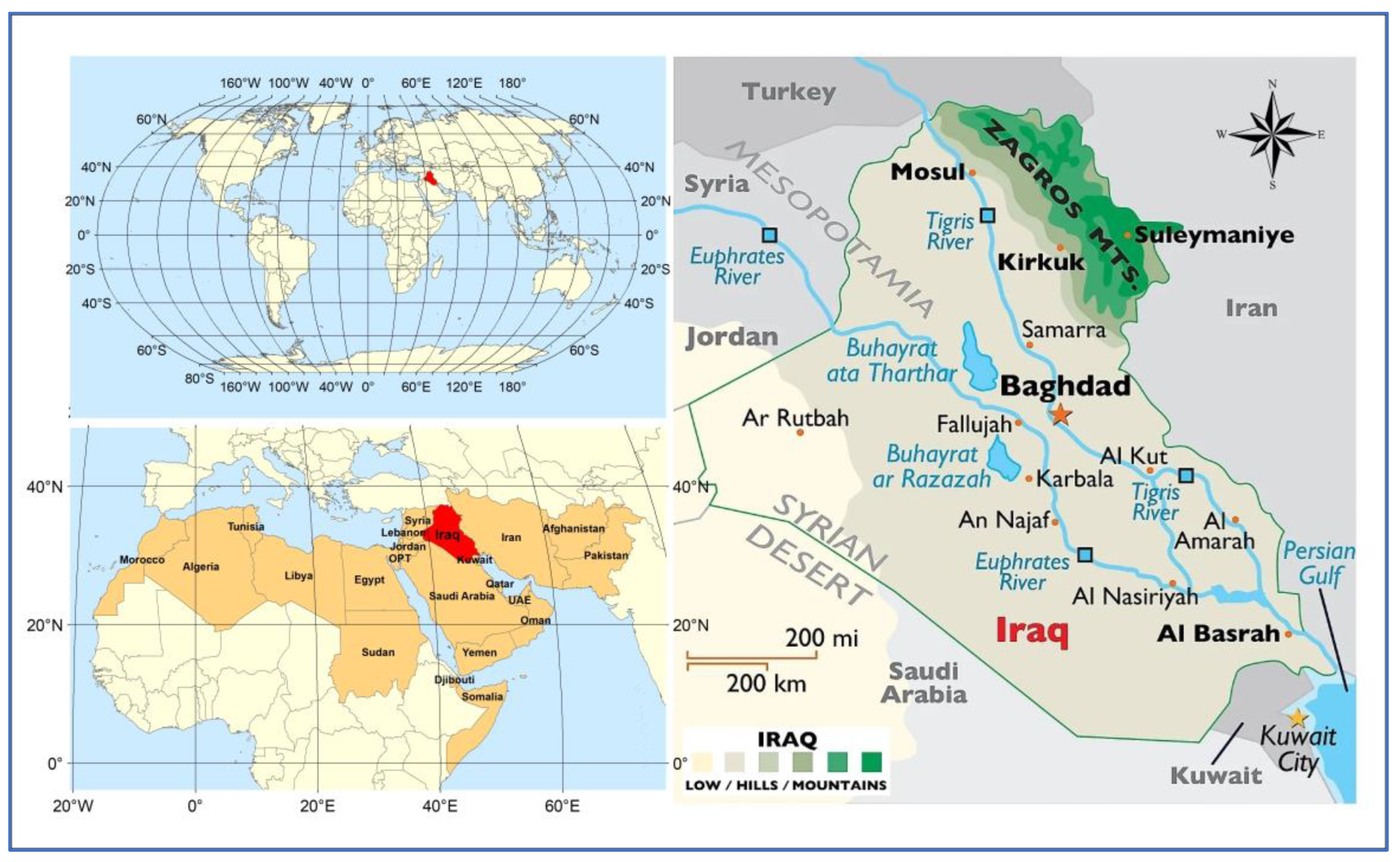




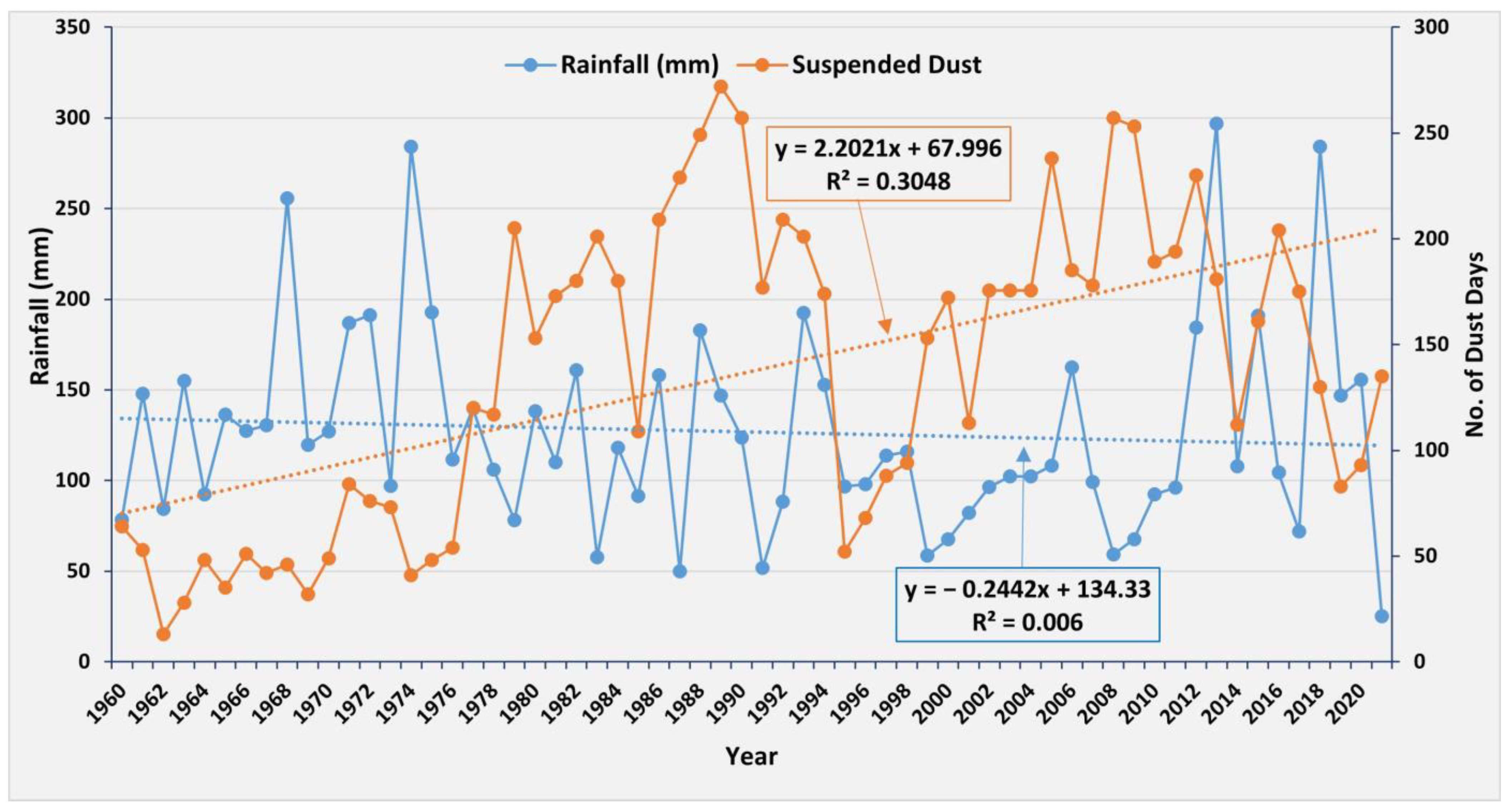
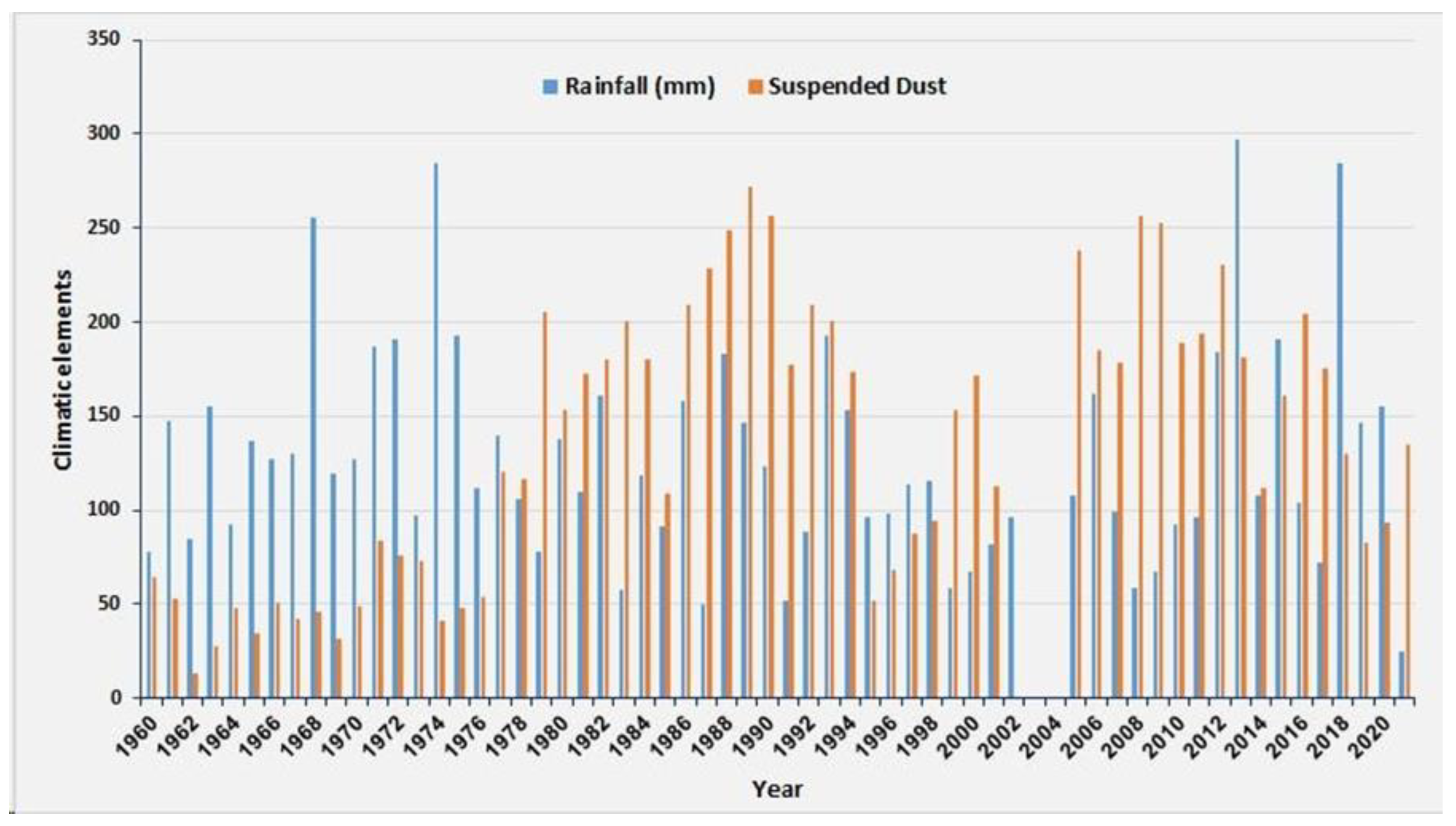
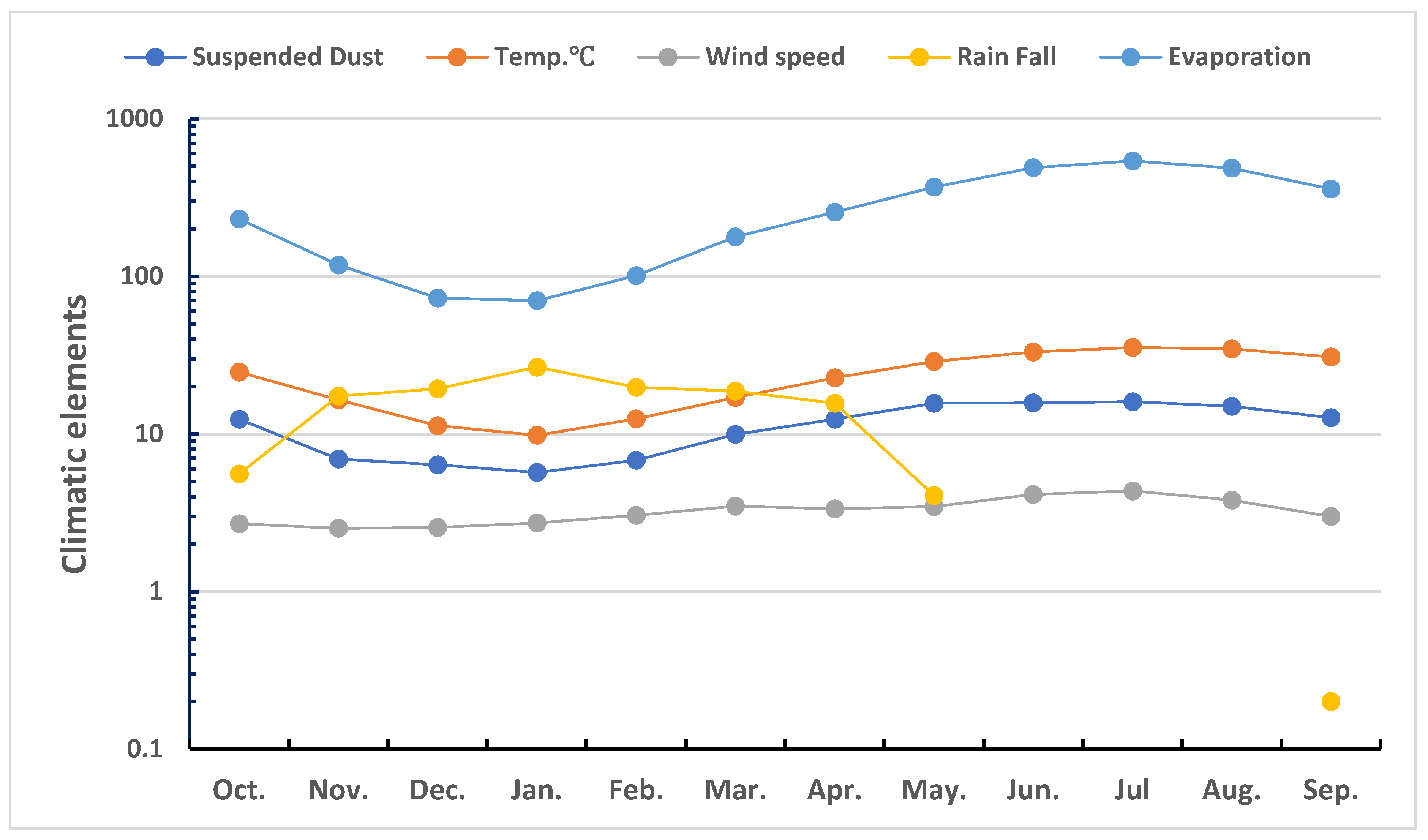
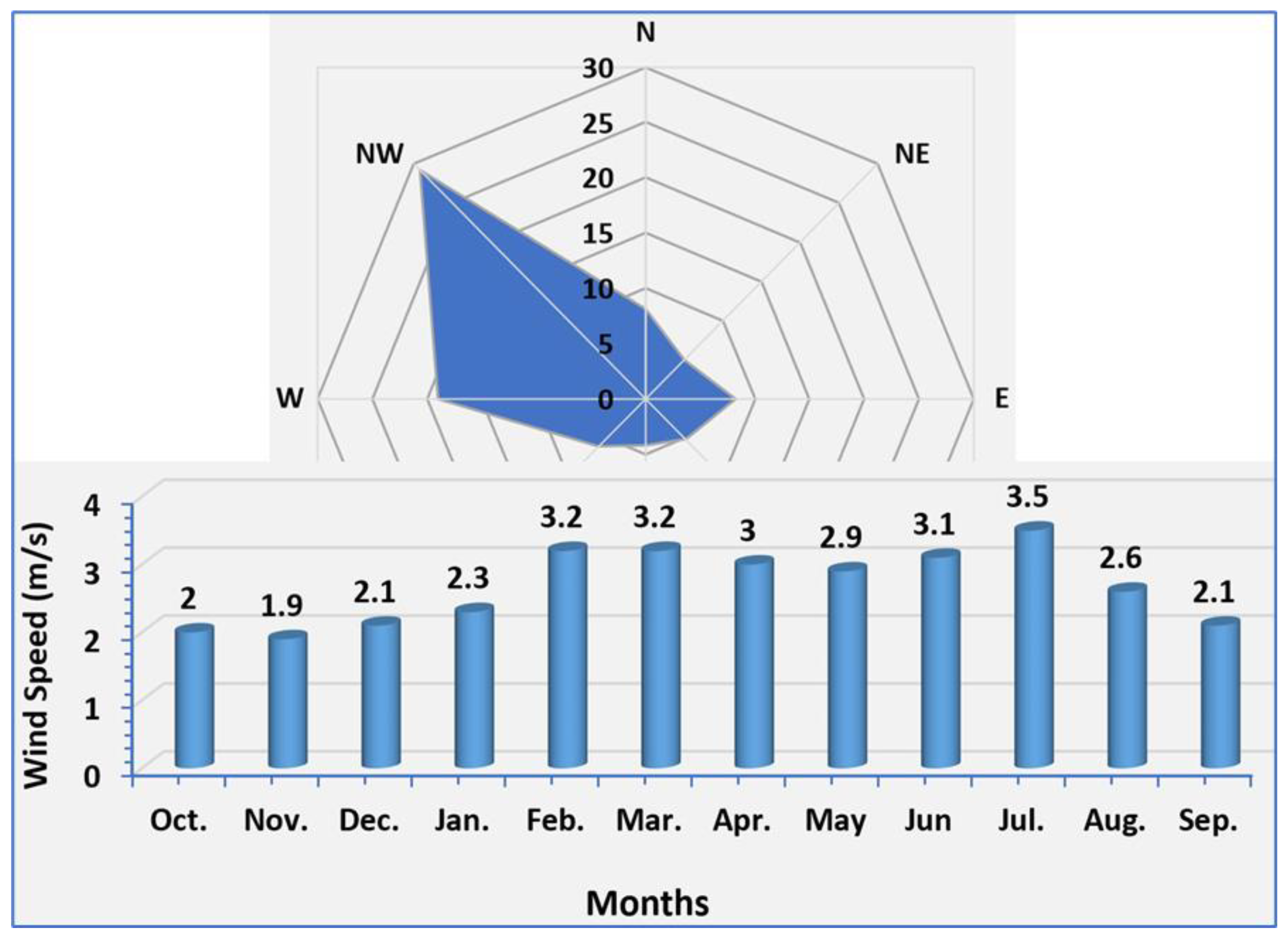

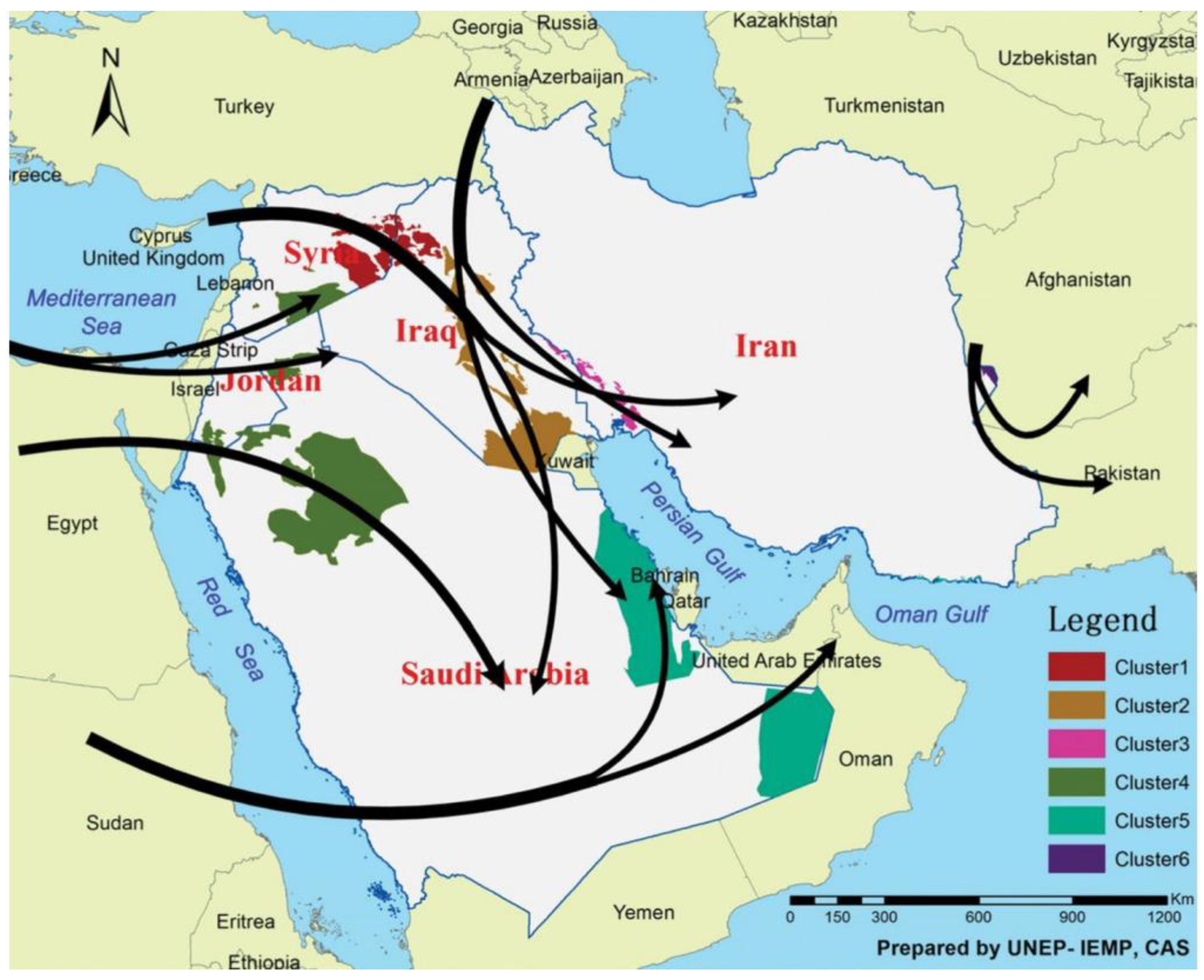
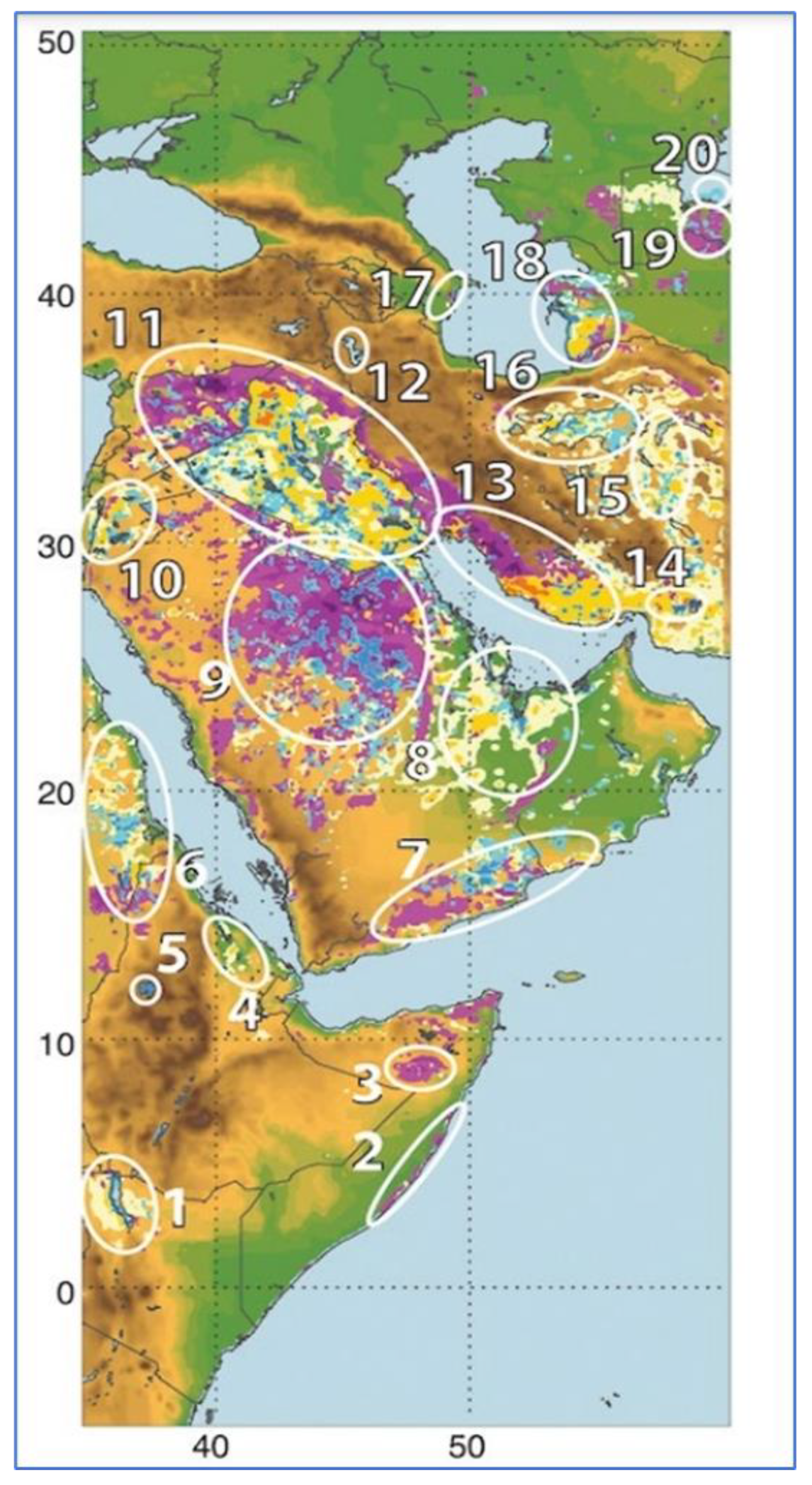
| Storm | Stat. | Size Fractions (%) | * Light Minerals (%) | * Heavy Minerals (%) | ||||||||||||
|---|---|---|---|---|---|---|---|---|---|---|---|---|---|---|---|---|
| Sand | Silt | Clay | Qtz | Fel | Cal | Gyp | Dol | Zi | Py | Ho | Ch | Ma | To | Ga | ||
| SSs | Min. | 66 | 21 | 1.0 | 51 | 10 | 1.8 | 0.1 | 0.1 | 6.6 | ||||||
| Av. | 72.7 | 25.1 | 2.2 | 65 | 23 | 5.0 | 0.4 | 1.0 | ||||||||
| Max. | 78 | 32 | 4.0 | 72 | 30 | 12 | 1.1 | 2.0 | ||||||||
| SD | SD | 6.1 | 5.5 | 1.5 | 10. | 10.2 | 5.2 | 0.51 | ||||||||
| DSs | Min. | 6.0 | 17 | 68 | 33 | 3.3 | 25 | 2.2 | 0.5 | 3.2 | ||||||
| Av. | 9.4 | 20.6 | 70 | 49 | 5.0 | 36 | 5.0 | 2.4 | ||||||||
| Max. | 13 | 23 | 72 | 55 | 7.9 | 57 | 8.1 | 1.2 | ||||||||
| SD | 3.5 | 3.0 | 2.0 | 11.3 | 2.3 | 16.2 | 3.0 | 0.9 | ||||||||
| Country | Population | Annual PM10 | Urban Population | Deaths per Year | DALYs */Capital per Year |
|---|---|---|---|---|---|
| Afghanistan | 24,076 | 27 | 16 | 400 | 0.3 |
| Egypt | 71,550 | 136 | 32 | 15,500 | 2 |
| Iran | 68,669 | 68 | 42 | 9100 | 1 |
| Iraq | 27,456 | 167 | 58 | 10,300 | 6 |
| Palestine | 6574 | 53 | 80 | 1400 | 1.1 |
| Jordan | 5371 | 69 | 49 | 700 | 1.1 |
| Kuwait | 2617 | 129 | 74 | 300 | 1.1 |
| Lebanon | 3965 | 43 | 74 | 400 | 1.6 |
| Libya | 5799 | 121 | 85 | 1800 | 3 |
| Morocco | 30,152 | 27 | 37 | 900 | 0.2 |
| Oman | 2479 | 124 | 36 | 300 | 1.1 |
| Pakistan | 155,333 | 165 | 27 | 30,000 | 2 |
| Qatar | 764 | 57 | 65 | <100 | 0.4 |
| Saudi Arabia | 23,047 | 91 | 40 | 2500 | 1.1 |
| Syria | 18,389 | 89 | 38 | 1800 | 0.9 |
| Tunisia | 9996 | 46 | 30 | 800 | 0.6 |
| United Arab Emirates | 3947 | 109 | 70 | 200 | 0.7 |
| Yemen | 20,478 | 82 | 15 | 1100 | 0.7 |
Disclaimer/Publisher’s Note: The statements, opinions and data contained in all publications are solely those of the individual author(s) and contributor(s) and not of MDPI and/or the editor(s). MDPI and/or the editor(s) disclaim responsibility for any injury to people or property resulting from any ideas, methods, instructions or products referred to in the content. |
© 2023 by the author. Licensee MDPI, Basel, Switzerland. This article is an open access article distributed under the terms and conditions of the Creative Commons Attribution (CC BY) license (https://creativecommons.org/licenses/by/4.0/).
Share and Cite
Awadh, S.M. Impact of North African Sand and Dust Storms on the Middle East Using Iraq as an Example: Causes, Sources, and Mitigation. Atmosphere 2023, 14, 180. https://doi.org/10.3390/atmos14010180
Awadh SM. Impact of North African Sand and Dust Storms on the Middle East Using Iraq as an Example: Causes, Sources, and Mitigation. Atmosphere. 2023; 14(1):180. https://doi.org/10.3390/atmos14010180
Chicago/Turabian StyleAwadh, Salih Muhammad. 2023. "Impact of North African Sand and Dust Storms on the Middle East Using Iraq as an Example: Causes, Sources, and Mitigation" Atmosphere 14, no. 1: 180. https://doi.org/10.3390/atmos14010180
APA StyleAwadh, S. M. (2023). Impact of North African Sand and Dust Storms on the Middle East Using Iraq as an Example: Causes, Sources, and Mitigation. Atmosphere, 14(1), 180. https://doi.org/10.3390/atmos14010180







